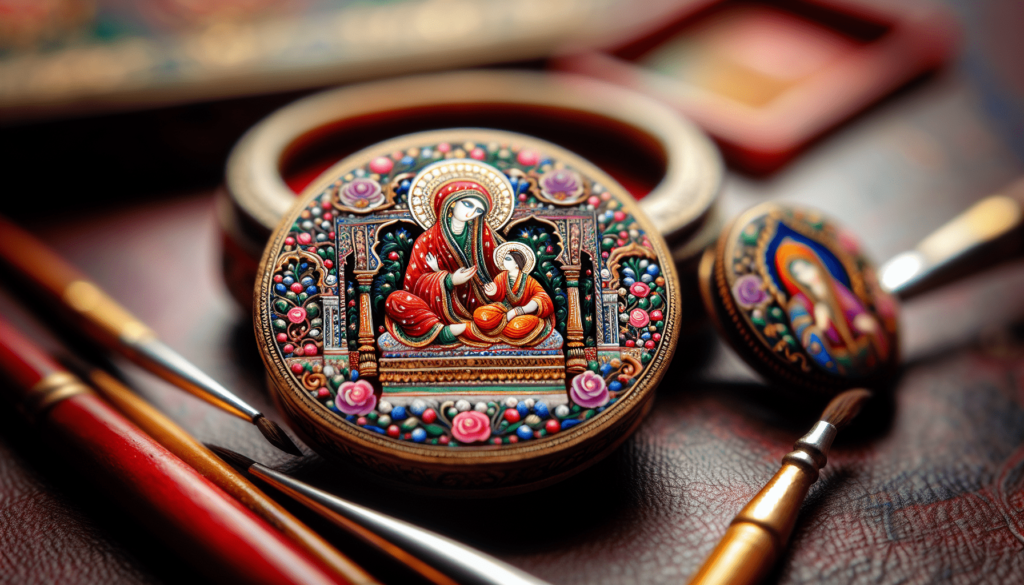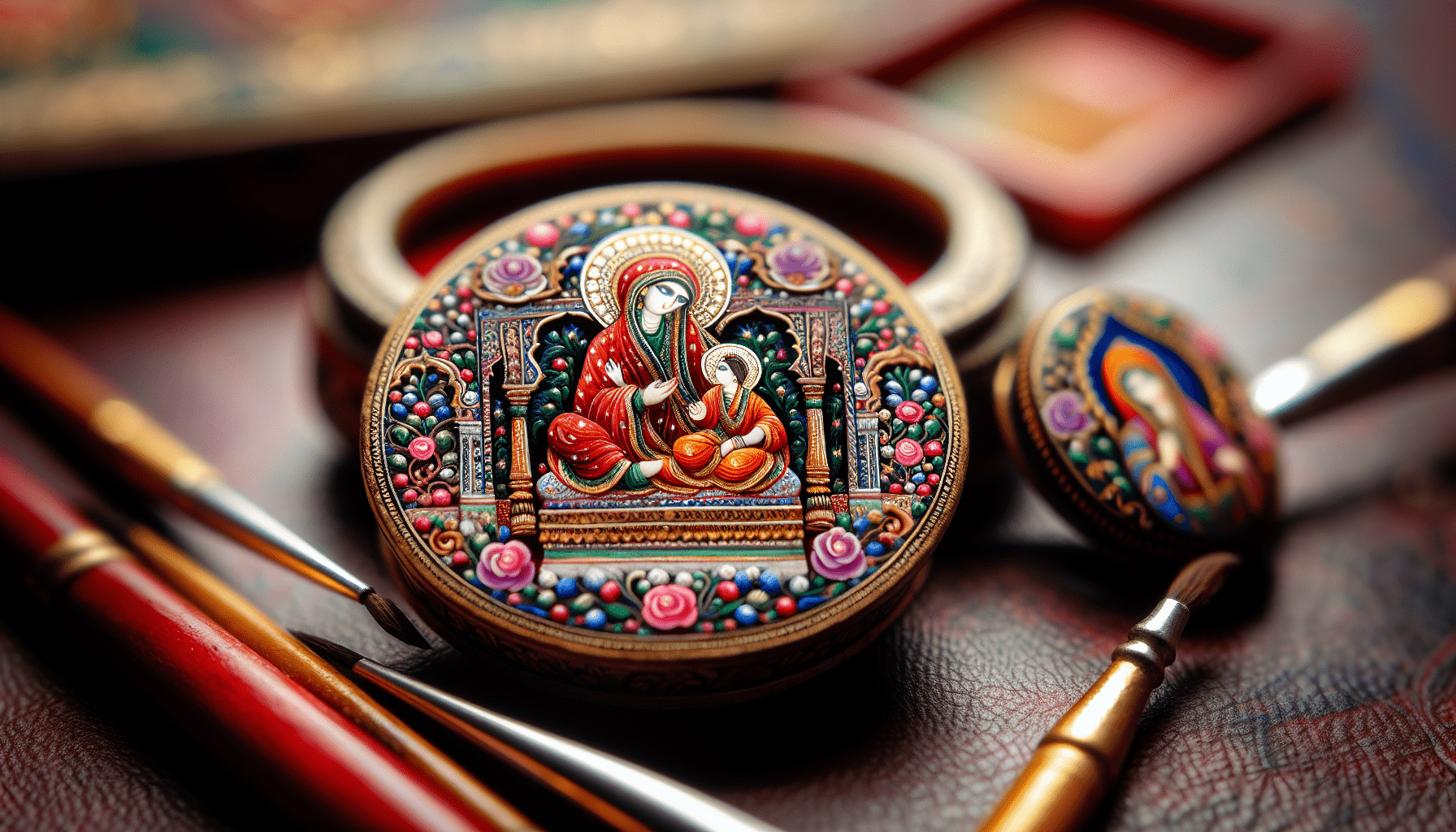In the world of art, color plays a vital role in captivating the viewer’s attention and evoking emotions. This is particularly true in the realm of miniature artworks, where every brushstroke and color choice holds immense significance. From delicate watercolor landscapes to intricate miniature portraits, the use of color in these small-scale masterpieces is what breathes life into them. Join us as we explore the mesmerizing world of miniature art and how color takes center stage in its creation. Get ready to be enchanted by the power of colors, as we delve into the role they play in these tiny yet awe-inspiring pieces of art.
Importance of color in miniature artworks
Color plays a significant role in the world of miniature art. It has the power to evoke emotions, enhance visual appeal, and convey meaning and symbolism. In this article, we will explore the various aspects of color in miniature art and understand its impact on emotions, mood, and storytelling.
The impact of color on emotions and mood
Colors have the ability to evoke specific emotions and set the mood of a piece of art. Warm colors like red, orange, and yellow can evoke feelings of energy, passion, and excitement. On the other hand, cool colors like blue, green, and purple can create a sense of serenity, peace, and tranquility. By strategically using different colors, miniature artists can create a specific emotional atmosphere in their artworks.
How color enhances the visual appeal of miniatures
Color is a powerful tool that enhances the visual appeal of miniature artworks. It adds vibrancy, depth, and dimension to the artwork, making it visually captivating. Whether it is a landscape painting or a figurine, the thoughtful use of color can bring the artwork to life and make it visually engaging for the viewers.
Symbolism and meaning associated with colors in miniature art
Colors have symbolic meanings that vary across different cultures and contexts. In miniature art, certain colors are often associated with specific symbols and meanings. For example, red can symbolize love and passion, while blue can represent tranquility and peace. By incorporating these symbolic colors into their artworks, miniature artists can add layers of meaning and create a deeper connection with the viewers.
Color theory in miniature art
Understanding color theory is crucial for artists who work with miniatures. It helps them make informed decisions about color selection, contrast, and harmony in their artworks.
Understanding the color wheel and its application
The color wheel is a fundamental tool used by artists to understand the relationships between colors. It consists of primary, secondary, and tertiary colors arranged in a circular format. By understanding how colors interact with each other on the color wheel, miniature artists can create harmonious color schemes and make informed decisions about color combinations.
Contrast and harmony in color selection
Contrast and harmony are essential elements in color selection. Contrast involves using colors that are opposite or significantly different from each other on the color wheel to create visual interest and make certain elements stand out. On the other hand, harmony involves using colors that are adjacent or related to each other on the color wheel to create a sense of unity and cohesion in the artwork. Striking the right balance between contrast and harmony can greatly enhance the overall visual impact of a miniature artwork.
Exploring warm and cool color palettes
Warm and cool color palettes offer different effects and evoke distinct moods. Warm color palettes, consisting of reds, oranges, and yellows, can create a sense of energy and vibrancy in the artwork. They are often used to convey warmth, passion, and intensity. On the other hand, cool color palettes, consisting of blues, greens, and purples, can create a sense of calmness, tranquility, and peacefulness. Miniature artists can experiment with warm and cool color palettes to evoke different emotions and create varied atmospheres in their artworks.

Psychological effects of colors in miniature art
Colors have psychological effects on viewers, and miniature artists can leverage these effects to create specific emotional responses in their audience.
Use of warm colors to evoke feelings of energy and passion
Warm colors like red, orange, and yellow can evoke feelings of excitement, energy, and passion. When used in miniature art, they can create a sense of dynamism and intensity, capturing the attention of the viewer. By strategically incorporating warm colors in their artworks, artists can elicit strong emotional responses from the viewers.
Cool colors for creating a sense of serenity and peace
Cool colors like blue, green, and purple have a calming and soothing effect on viewers. They can create a sense of serenity, peace, and tranquility in miniature artworks. Artists can use cool colors to create a calming atmosphere or convey a sense of relaxation and harmony to the viewers.
The influence of neutral colors in creating balance
Neutral colors, such as gray, beige, and brown, have a balancing effect in miniature art. They can create a sense of stability, reliability, and timelessness. By using neutral colors, artists can bring balance to their artworks and create a cohesive composition. Neutral colors also provide a foundation for other colors to stand out and shine.
Techniques for using color in miniature painting
Using various techniques, artists can effectively utilize color in their miniature paintings to create depth, richness, and dimension.
Layering and glazing to achieve depth and richness
Layering and glazing techniques involve applying multiple layers of transparent or translucent paint over each other. This technique adds depth to the artwork by creating a sense of overlapping colors and textures. By building up layers, artists can achieve richness and complexity in their miniature paintings. This technique is particularly effective in creating realistic textures and surfaces.
Color mixing and blending for seamless transitions
Color mixing and blending techniques are essential for achieving smooth and seamless transitions between colors in miniature artworks. Skillful color mixing allows artists to create subtle gradations and variations in tone and hue. It helps in achieving realistic shading and smooth color transitions, creating a sense of dimensionality and realism in the artwork.
Highlighting and shading to create dimension
Highlighting and shading techniques are crucial for creating the illusion of three-dimensional forms in miniature paintings. By adding highlights to areas that catch the light and shadows to areas in shadow, artists can create the appearance of depth and dimension. These techniques add realism and visual interest to the artwork, making it more engaging for the viewers.

Color symbolism in miniature art
Colors hold symbolic meanings, and artists can use them intentionally to convey specific meanings and messages in their miniature artworks.
How different colors convey specific meanings and messages
Different colors convey specific meanings and messages. For example, red often represents love, passion, and power, while blue symbolizes peace, tranquility, and spirituality. Artists can utilize these color associations to communicate certain ideas or emotions in their miniature artworks. By choosing colors with intention, they can add layers of symbolic meaning to their artwork and engage viewers on a deeper level.
The use of complementary colors to create visual impact
Complementary colors are pairs of colors that are opposite each other on the color wheel, such as red and green or blue and orange. When used together, complementary colors create visual impact and attract the viewer’s attention. By strategically incorporating complementary colors in their miniature art, artists can create a dynamic and visually striking composition.
Symbolic color choices in narrative miniature artworks
In narrative miniature artworks, color choices can be used to enhance the storytelling aspect of the artwork. Artists can use specific colors to represent different characters, scenarios, or emotions in the narrative. By associating certain colors with specific elements of the story, artists can create a visual language that adds depth and richness to the narrative.
Color as a storytelling element in miniature art
Color can play a crucial role in setting the mood, depicting emotions, and creating a cohesive narrative in miniature art.
Using color to set the mood and atmosphere of a scene
Color has the power to set the mood and atmosphere of a scene in miniature art. By choosing specific colors, artists can create a particular emotional tone that aligns with the narrative or the desired impact on the viewer. For example, using warm colors like red and orange can create a vibrant and energetic atmosphere, while cool colors like blue and green can create a calm and peaceful ambiance.
Depicting emotions through color choices
Color choices can effectively depict emotions in miniature artworks. Vibrant and intense colors like red or yellow can evoke excitement or joy, while muted and desaturated colors can convey sadness or melancholy. By carefully selecting colors that reflect the intended emotions, artists can capture and communicate a wide range of emotional experiences within their miniatures.
Creating a cohesive color scheme for a themed miniature collection
In a themed miniature collection, creating a cohesive color scheme is crucial to maintain visual harmony and consistency. By selecting a specific color palette or combination of colors, artists can tie together different pieces within the collection and create a sense of unity. A cohesive color scheme enhances the visual impact of the collection as a whole and strengthens the overall narrative or theme.
The role of color in enhancing realism in miniature art
To create realistic and lifelike miniature artworks, artists must understand the role of color in portraying lighting, texture, and materiality.
Understanding color temperature and its effect on perception
Color temperature refers to the perceived warmth or coolness of a color. Warm colors, such as red or orange, appear to advance towards the viewer and can create a sense of warmth and proximity. Cool colors, such as blue or green, appear to recede and can create a sense of distance or coolness. By understanding color temperature, artists can accurately represent the effect of lighting on objects and create a convincing sense of space within their miniatures.
Using color variations to depict texture and materiality
Colors can be used to depict different textures and materials in miniature artworks. By incorporating subtle color variations, artists can simulate the appearance of various surfaces, such as rough or smooth textures, metal or fabric materials, and natural or man-made elements. These color variations add realism and detail to the artwork, making the miniature come alive for the viewer.
Controlling color intensity for realistic lighting effects
Color intensity refers to the purity or saturation of a color. By controlling the intensity of colors, artists can create realistic lighting effects in their miniature artworks. Bright and highly saturated colors can represent areas of direct light, while desaturated or muted colors can represent areas of shadow or indirect light. Skillful control of color intensity allows artists to accurately portray the interplay between light and shadow, adding depth and realism to their miniatures.
Cultural influences on color choices in miniature art
Color choices in miniature art can be influenced by cultural contexts and traditions. Artists can explore diversity and adapt color choices to connect with specific audiences.
Color symbolism in different cultures and art traditions
Colors often hold different symbolic meanings in different cultures and art traditions. For example, red is associated with luck and celebration in Chinese culture, while white symbolizes purity and innocence in Western culture. By understanding the cultural symbolism of colors, artists can make intentional color choices that resonate with specific audiences or cultural contexts.
Exploring cultural diversity through color palettes
Artists can embrace cultural diversity by incorporating a wide range of colors and color palettes in their miniature artworks. By exploring colors traditionally associated with different cultures, artists can celebrate diversity and create inclusive art that appeals to a global audience. Introducing new color palettes can also enrich the visual language and expand the possibilities of miniature art.
Adapting color choices to resonate with a specific audience
In addition to cultural influences, artists can adapt their color choices to resonate specifically with a target audience or community. By understanding the preferences and associations of a particular audience, artists can select colors that evoke emotions, memories, or cultural references that are relevant to that audience. This personalized approach to color can create a stronger connection between the artwork and the viewer, enhancing the overall impact of the miniature.
Experimenting with unconventional color schemes in miniature art
Artists can break traditional color norms and experiment with unconventional color schemes to create unique visual impact and push the boundaries of miniature art.
Breaking traditional color norms to create unique visual impact
Through unconventional color choices, artists can challenge traditional norms and expectations in miniature art. By stepping outside the comfort zone of predefined color schemes, artists can capture attention, evoke curiosity, and engage viewers in a new and unexpected way. Experimenting with unconventional color schemes can lead to fresh and exciting artistic discoveries.
Exploring monochromatic and limited color palettes
Monochromatic color schemes involve using different shades, tints, and tones of a single color. This technique can create a harmonious and calming effect in miniature art. Limited color palettes restrict the number of colors used in an artwork to create a focused and cohesive visual impact. By exploring both monochromatic and limited color palettes, artists can push their creativity and find innovative ways to express their artistic vision within self-imposed limitations.
Using unexpected color combinations for an artistic challenge
Using unexpected color combinations challenges artists to think outside the box and take risks in their artistic practice. By intentionally pairing colors that are not traditionally considered to be harmonious, artists can create a sense of tension, intrigue, or surprise. This artistic challenge can lead to unconventional and visually compelling miniature artworks that capture the viewer’s attention and spark their curiosity.
Color as an expression of personal style in miniature art
Color choices can reflect an artist’s personal style, preferences, and individuality. Through intentional color selection, artists can communicate their unique artistic voice.
Developing a signature color palette as an artist
Many artists develop a signature color palette that becomes synonymous with their work. This unique collection of colors reflects an artist’s personal style, preferences, and artistic vision. By consistently using their signature color palette, artists can create a recognizable visual identity and establish their artistic voice in the world of miniature art.
Exploring personal preferences and associations with colors
Artists often have personal preferences and associations with specific colors. The colors that resonate with an artist on an emotional or personal level can greatly influence their artistic choices. By exploring their own preferences and associations with colors, artists can infuse their miniature art with a sense of personal connection and authenticity.
Using color to communicate individuality and artistic voice
Color is a powerful tool for artists to communicate their individuality and artistic voice. By selecting specific colors and color combinations, artists can evoke certain emotions, convey personal narratives, and express their unique perspective on the world. Through intentional and thoughtful use of color, artists can leave their mark on the miniature art world and create a lasting impression on the viewers.
In conclusion, color plays a pivotal role in miniature artworks. As artists explore the impact of color on emotions, employ color theory techniques, consider the psychological effects, experiment with unconventional color schemes, and utilize color symbolism, they can enhance the visual appeal, storytelling, and realism in their miniature art. By understanding cultural influences and embracing personal style, artists can create unique and captivating miniature artworks that resonate with viewers and leave a lasting impression. With color as their palette, miniature artists have the power to evoke emotions, convey meaning, and express their individuality in this fascinating and intricate art form.

Leave a Reply